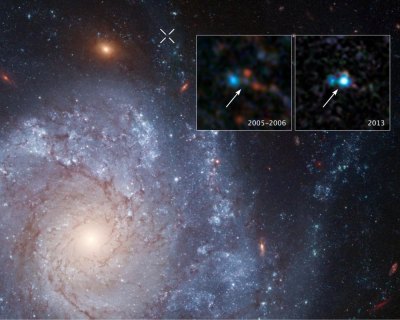NASA In Brief -- Astronomers using Hubble spot "zombie star"

A supernova was seen using the Hubble Space Telescope. Image: NASA and the European Space Agency.
A supernova usually obliterates the exploding white dwarf, or dying star. Scientists believe this faint supernova may have left behind a surviving portion of the dwarf star -- a sort of zombie star.
While examining Hubble images taken years before the stellar explosion, astronomers identified a blue companion star feeding energy to a white dwarf, a process that ignited a nuclear reaction and released a weak supernova blast. Astronomers have identified more than 30 of these mini-supernovas that may leave behind a surviving white dwarf.
The team’s results appear in the Aug. 7 edition of the journal Nature.
NEXT ROUND OF INITIATIVE LAUNCHED: NASA is opening the next round of its CubeSat Launch Initiative in an effort to engage the growing community of space enthusiasts.
The program gives students and teachers a chance to get hands-on flight hardware development experience in designing, building and operating small research satellites. The CubeSat Launch Initiative also provides a low-cost pathway to space for research in science, exploration, technology development, education or operations consistent with NASA's strategic plan.
Applicants must submit their proposals electronically by 4:30 p.m. EST, Nov. 25. NASA will select the payloads by Feb. 6, 2015, but selection does not guarantee a launch opportunity. Selected experiments could be flown as auxiliary payloads on NASA rocket launches or deployed from the International Space Station beginning in 2015 and running through 2018. NASA does not provide funding for the development of the small satellites, and this opportunity is open only to U.S. nonprofit organizations and accredited educational organizations.
One goal of the CubeSat Launch Initiative is to extend the successes of space exploration to all 50 states by launching a small satellite from at least one participant in each state in the next five years. NASA is particularly focused this round on participation in the District of Columbia, Puerto Rico, and 21 states not previously selected: Arkansas, Delaware, Georgia, Idaho, Iowa, Kansas, Maine, Minnesota, Mississippi, Nebraska, Nevada, New Hampshire, New Jersey, North Carolina, Oklahoma, Oregon, South Carolina, South Dakota, Washington, West Virginia and Wyoming.
The base CubeSat dimensions are about 4-by-4-by-4 inches (10-by-10-by-11 centimeters), which equals one "Cube."
To date, NASA has selected 114 CubeSats from 29 states, 17 of which have been launched. Nine more CubeSats are scheduled to go into space in the next 12 months.
For additional information about the program, visit the NASA website.
Related:
NASA In Brief--Students to compete in rocket challenge
NASA In Brief --Hubble captures comet flyby

